|
|
|
|
Products mentioned in this Article
--None--
|
|
|
|
|
|
|
|
|
 |
|
|
|
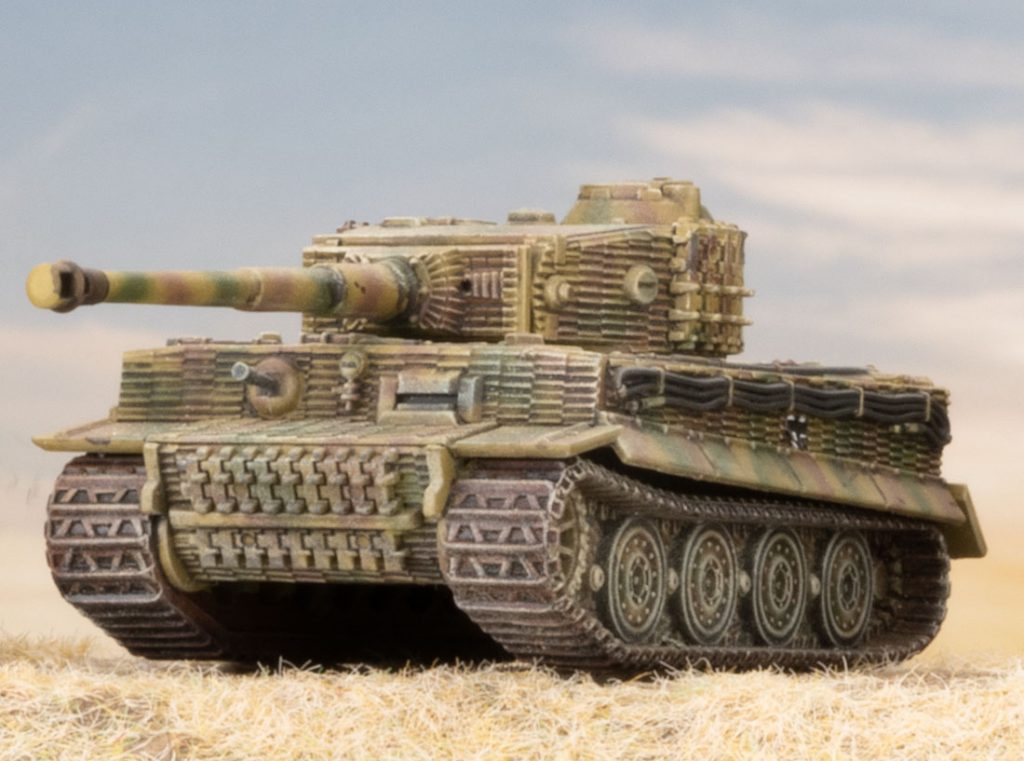
|
Hungarian Heavies
with Livio Tonazzo
Tiger and Panthers in Hungarian service
One of the most exciting novelties of the new book Bagration: Axis Allies undoubtedly concerns the Hungarians. They are in fact the only ones among the minor Axis powers who are able to field two of the most iconic tanks of the Second World War. We are talking of course the Tiger and the Panther.
|
|
In 1941 at the time of Operation Barbarossa, Hungary proved reluctant to go to war with the Soviet Union. Nevertheless, the Hungarian troops participated in the offensive being called to cover the flanks of the German 6th Army which fought in the rubble of Stalingrad. The Hungarians tried to resist at all costs against the overwhelming Soviet offensive of Christmas 1942 and the Hungarian armoured forces were almost completely destroyed on that occasion. After the defeat and subsequent retreat, the Hungarian forces settled near Novi Oskol. Here they were relegated to secondary tasks such as occupation and patrolling. At the beginning of 1944, the Hungarian desire to continue the war was falling. The Germans understood the situation perfectly and effectively occupied the country reducing Hungary to a puppet state which meant that the Hungarian army would therefore continue the war.
|
|
With the idea of strengthening the Hungarian armoured component (which was somewhat outdated), the Germans began to supply more and more tanks such as the Tiger and Panther, but also Panzer IV, Hetzer and Stug III. In May 1944 the 2nd Armoured Division received 10 Tiger I E to replace Turán tanks while it was fighting in Galicia. Two more Tigers were delivered in July and one in August. Interestingly these Tigers came from German units that had begun the process of converting to the new Tiger II heavy tank and still had German markings. Hungarian Tigers were fielded in small companies of five to six tanks under the command of Ervin Tarczay and János Vedress.
Hungarian Panthers came a little bit later than the Tigers and it was August 1944, when the 2nd Armored Division received five Panther A tanks which came under the command of Ervin Tarczay’s 2nd Company. Another ten to twelve Panthers originally destined for Romania may have been redirected to the Hungarians in September following the Romanian defection to the Allies. Ultimately Tiger and Hungarian Panther are few in number, but ready to fight!
|
|
Tiger and Panther in Flames Of War
Tigers and Panthers are some of the most famous tanks of World War II. Almost all players know them and have faced them on the battlefield. We will not dwell long on the profile but the clear fame surrounding these tanks still requires us to review the profile.
The Tiger can boast a truly enviable Armor. With a Front Armor value of 9, it can completely ignore many shots fired on the battlefield. To even hope to destroy a Tiger you need an Anti-tank value of 11 at short range! Late War however has several weapons capable of piercing this armour so you must still pay close attention to how to move the Tiger on the battlefield (unlike Mid War when it can run almost undisturbed very often). The Side Armor is another of the Tiger’s strong points. The value of 8 makes it exceptional in assaults as most infantry Anti-tank weapons have an Anti-tank value ranging from 10 to 11. A Side Armor of 8 also makes it not so vulnerable to flanking. Often what you are dealing with when an enemy flanks you are usually facing light tanks. It is too bad for them that not many light tanks have an anti-tank of 10 which is the minimum value needed to hope to destroy a Tiger on the sides.
The Top Armor of 2 confirms just how formidable the Tiger is in assaults. Infantry without anti-tank weapons are completely helpless and cannot hope to bail a Tiger, only to repel it.
|
|
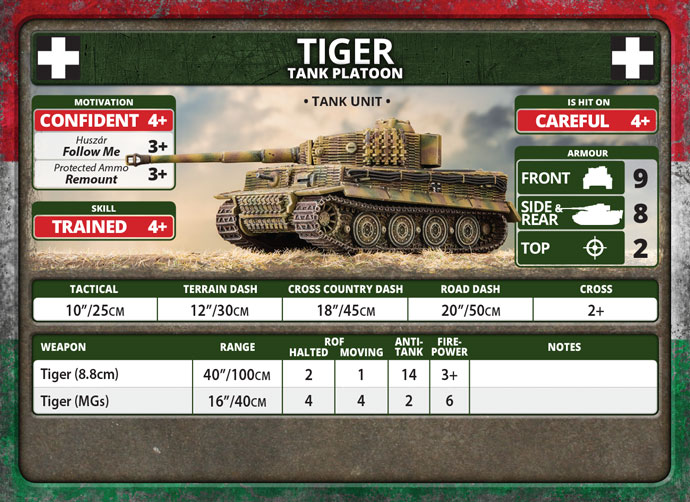
|
|
This heavy tank is as heavily armoured as it is heavily armed. It mounts a very effective 8.8cm cannon that is capable of destroying almost any tank that comes in front of it. It is anti-tank 14 and firepower 3+ can hit and destroy virtually all enemy tanks within 40 “. The rate of fire is also good (the 88 was born as an anti-aircraft gun!), Having a ROF of 2 while Halted and 1 while moving. To deal with infantry the Tiger has two machine guns, one on the hull and one coaxial with these 4 machine-gun shots which can come in handy for dealing with infantry. Despite the thick armour and the powerful cannon, the Tiger is not a slow tank. The 57 tons of this tank are powered by a Maybach HL230P45 12-cylinder 60 ° V petrol engine which guarantees an excellent power-to-weight ratio. In Flames of War, the Tiger can move tactically at 10 “, exactly like almost all medium tanks. As for the Dash movements, the Tiger can move 18 “on Cross-Country, 20” on road and 12 “on terrain. These are more than good values, especially for a heavy tank. In addition, the wide tracks guarantee the Tiger a Cross value of 2+ so the terrain is not a problem! The cost in points is of course proportionate to such a dominating profile with most Tiger tanks costing so much that a formation will often use most of your points.
|
|
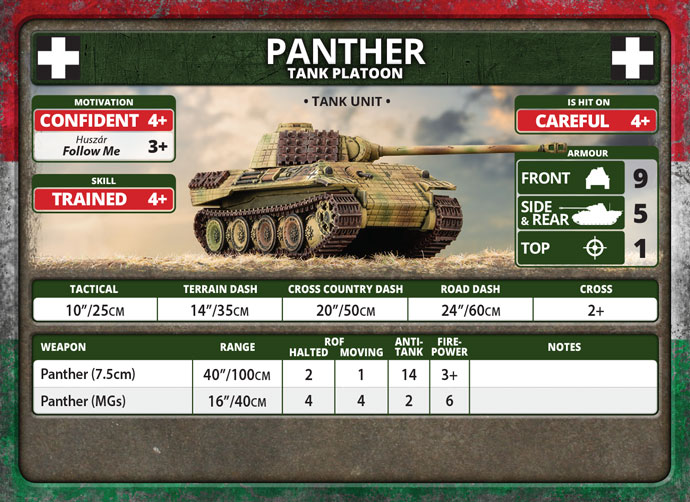
|
|
The Panther is the definitive version of the WWII German medium tank often putting to shame what the Allies would call a “medium tank”. Inspired by the Soviet T-34 and developed from 1941 it entered service in Kursk. In 1944 (and also in 1945) The Panther was still an excellent tank and able to face almost all the opposing counterparts. Although it was a medium tank, its thick armour and its inclination guaranteed it excellent protection. This is represented in Flames of War with a Front Armor of 9 which is equal to or better than other enemy heavy tanks. The Side Armor has a value of 5, better than that of other medium tanks but not exceptional. The Panther is therefore not a particularly suitable tank for assaults as it can be knocked out by medium anti-tank guns or even by light ones if one is particularly unlucky. The Top Armor of 1 confirms what has just been said, in a close combat the Panther has no better protection than a Panzer II. On the other hand this less protection on the sides and top which makes the Panther a lighter tank than the Tiger. Being “only” 45 tons and powered by a Maybach HL230P30 12-cylinder petrol-powered engine the Panther can move very quickly on the battlefield. Although the Tactical Speed is only 10 “, the Panther can move 20” on Cross-Country Dash, 14 “on Terrain Dash (with a Cross value of 2+) and 24” on Road Dash. The Panther is equipped with a 7.5cm high-speed cannon with a performance equal to that of the famous 88. An anti-tank value of 14 and firepower of 4+ makes it superior to practically all enemy and capable medium tanks. to face almost all heavy tanks. Two machine guns grant them adequate protection against infantry. Again such features are not cheap with the Panther costing a little less than a Tiger.
Summing up, the Tiger and Panther are two tanks that can look very similar with Front Armor values of 9 and anti-tank 14 guns. On the battlefield, however, these two tanks play completely different roles. The Tiger is a heavy tank that gives its best in assaulting enemy infantry but that can also engage enemy tanks, certainly outperforming the other Allied tanks and facing heavy ones on an equal footing. The Panther, on the other hand, is a particularly protected medium tank that can engage and destroy almost any tank that comes in front of it, perhaps even flanking an enemy tank thanks to their movement. It is essential not to confuse the roles or you will receive some unpleasant surprises.
|
|
Hungarian Tiger formation
The Hungarian Tigers naturally have the same profile as the German ones and they still have the German insignia! What differentiates them are of course training and morals. The Hungarians had little time to get used to the Tiger tank and did not develop an adequate doctrine to use them. This causes their crews to be considered Trained meaning they pass the various Skill Tests with a result of 4+, so these Tigers will have less chance of using a Blitz or a Shoot & Scott. If you consider that in Late War there are many weapons capable of piercing its excellent armour this disadvantage must be taken into account. Positioning the Tigers correctly is vital in order not to see them burn in short order. Their Careful 4+ hit rating should still offer some protection but don’t rely too heavily on it. Morale can be considered adequate thanks to the Confident rating, which allows you to pass the various tests with a result of 4+.
|
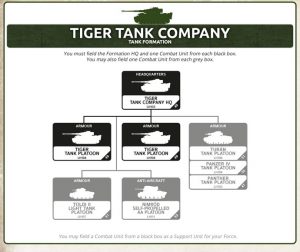
|
|
In addition, the Tiger’s Protected Ammo rule allows for a Remount value of 3+ which really helps a lot. Hungarians do not have the Third Reich rule but instead have their own national Huszar rule. It allows him to pass a Follow Me test with a result of 3+, making the Tigers faster. Overall the Hungarian Tiger is less skilled than the German one and the cost represents this difference with a slight discount.
|
|
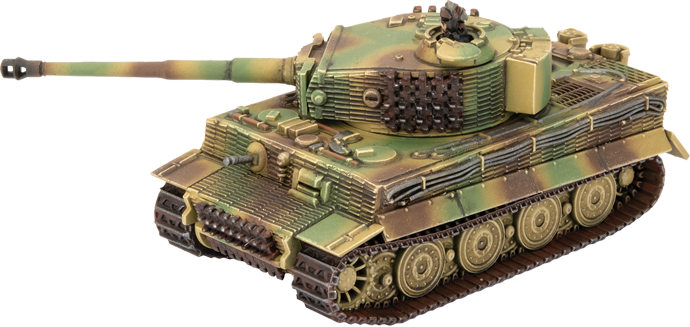
|
The HQ of a Tiger Tank Formation consists of a single tank. Tiger platoons consist of two or three Tigers. Personally, I always recommend deploying 3 as missing a Last Stand could make you lose about 1/3 of your army! It is possible to deploy two Tiger platoons in addition to the HQ platoon for a total of 7 Tigers, a nice challenge for any enemy Force. In addition to the Tiger platoons, there are 3 other units that can be deployed in the formation. The first slot is the one reserved for medium tanks and it is possible to choose between Turan, Panzer IV and Panther!
|
|
Using a platoon of medium tanks is a choice that I always recommend. They are useful for handling light tanks or armoured cars which when deployed in large numbers can gnaw the Formation around the Tigers. Their numbers supplement your Tigers allowing you to fire more shots and more targets. Among the three options, I tend to exclude the Panthers as they are more or less like the Tigers, leaving little room for other units. Sure a mixed formation of Tigers and Panthers is nice but you will have very few tanks and this could be a problem. The Turan is a medium tank of national production. It entered service in 1943 and was still in service in 1944 when it could be said to be almost obsolete. The 75mm version you can field can represent an economic choice to deploy a medium tank and save a few points. The worse courage and the less powerful gun (24 “, AT9, fp3 +, heat) compared to the Panzer IV guarantees it a significant discount. It is undoubtedly an alternative that must at least be considered. Another slot is the one reserved for Light tanks. Here too you can deploy a light tank of Toldi II. Lightly armoured and armed it should still find space in the formation thanks to the Scout and Spearhead rules that will give the formation more mobility. They have the advantage of being in the formation (making it more difficult to break the formation) as well as being able to manage enemy armoured cars without too many problems, especially in the Toldi IIa version which can boast good armour and a good anti-tank gun 7. The choice between Toldi II and Toldi IIa depends on how many points you have available since the armour comes at a cost.
|
|
Last but not least we have the anti-aircraft slot. The Swedish-designed Landsverk, called Nimrod in Hungarian service has proven to be a valuable weapon to limit Soviet air supremacy. With its 40mm gun, the Nimrod is effective enough for other roles as well. An anti-tank ranting of 7 and firepower 4+ are still respectable values especially with a rate of fire of 3 when stationary and 2 in motion. Considering that Tigers have a Top Armor value of 2 this is a useful but not essential choice. Sure they got more lethal against their missiles in Late War, but the point cost isn’t exactly low.
As we have seen the Hungarian Tiger Tank formation is varied and very often it will absorb a good part of the points at your disposal to complete.
|
|
Hungarian Panther Formation
Much of what has been said about the Tiger also applies to the Panther. Compared to its German counterpart it is less trained and for this reason, it will pass the various Skill tests with a result of 4+. Considering that the Side Armor and Top Armor are more fragile than those of the Tiger, carefully positioning the tank on the battlefield is even more important. The flanks are really dangerous since unlike the Tiger, the Panther does not have the Protected Ammo rule, so if Bailed, they can only Remount on a roll of 4+. The Panther, despite the 9’s Front Armor, is a bit of a Cinderella that needs to be treated with care! The formation is identical to that of the Tigers. The HQ platoon is made up of a single Panther while the Panther platoon can be made up of 2 or 3 Panthers.
|
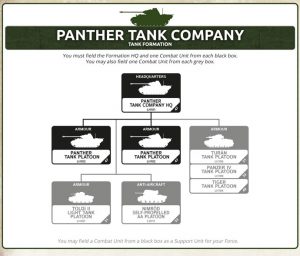
|
|
Similarly, the formation must consist of the HQ platoon and two Panther platoons. The recon slot and the anti-aircraft slot are exactly the same. It is worth noting, however, that Nimrods are much more important in a Panther formation than in a Tiger formation owing to its lower side and top armour. The Panther is not a cheap tank, even the Hungarian one costs about ten points so it is essential to protect it as much as possible from threats from above.
|
|
The slot reserved for medium tanks has an important difference in which can choose between Turan, Panzer IV or Tiger... However, what we have already said earlier about the Tiger formation holds much the same. If you want to field both Tiger and Panther you probably won’t get any points for anything else. The similarity of the formations is striking, despite the fact that the tanks in question are profoundly different. If you build either of the Tiger or Panther Formation however you will have very different needs in terms of support.
|
|
Conclusion
We talked in depth about the Panther and Tiger formations. Don’t forget, that both tanks are Compulsory Units for their respective formations. So you don’t have to field an entire formation to field Tigers or Panthers. They can serve as excellent support for other formations Such as Hungarian hussars supported by 3 mighty Tigers? Or the fearsome Zrinyi supported by 3 formidable Panthers? Some formations such as those of Panzer IV and Turan can even field Tigers and/or Panthers within their formations in non-compulsory slots. Usually including them in a medium tank formation reinforces the formation and is a good choice. Infantry can also benefit from choosing Tiger and Panther as support. Having about 30 points in a single platoon means that you have almost all the Force in the field already when the first reserve that arrives which can really change the course of a battle. Tigers are particularly suited to being deployed with infantry because they allow them to better attack other infantry. The Panthers, on the other hand, give their best in supporting other tanks, especially the lighter ones given the effectiveness in dealing with medium tanks. The possibilities are truly endless and you will really have a lot of fun with Hungarian heavies.
~Livio
|
Last Updated On Wednesday, January 24, 2024
|
|
|